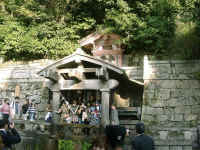 Page 1 2 3 4 5 6 7 8 9 10 11 12 13 14 15 16 Monday, 14 October. We spent a relaxing morning. Tom and I went for a walk down to the shore of nearby Lake Biwa, Japan's largest lake (260 sq. miles), then through some of the older neighborhoods. Tom pointed out some of the architectural features of the older houses. After lunch, the four of us took the train to Kyoto Station and went through some of the shops in the huge modern mall built around it. From there we went to the Sanju-sangen-do Temple, just across the Kamo River. The present building (1266) replaced an earlier one (1164) destroyed in a fire. It is remarkable for its length (almost 400 feet), most of it a single room housing 1,001 gilded statues of the Buddhist deity, Kannon, plus 30 statues of other deities.. The statues are carved from cypress wood. Then we took a taxi to the vicinity of the Kiyomizu (Pure Water) Temple, perched on a mountainside. This was the last day of the three-day holiday, and the whole area was very crowded. We decided not to climb the many steep steps to go into the Temple. Instead, we walked around it to the spring of pure water it's named for. There was a long line of people, mostly students, waiting to drink the flowing water, using the long-handled dippers provided. As we walked back through the Temple garden, we came across four geishas (or more likely, actresses dresses as geishas) who were posing for a professional photographer. We followed the narrow old streets down the mountain through some of Kyoto's oldest areas. We detoured along the way to stop at Tom's favorite sweet shop, where they gave us hot tea and samples of the sweets. As we continued down the crowded pedestrian street, we found a quiet garden off to one side, complete with a pond and a thatched-roof teahouse.
Some blocks further on, we came to Maruyama Park and the Yasaka Shrine, where people were lined up to pull the bell rope. The bell is supposed to wake the gods so they'll hear the petitioner's prayer. The Shrine is dedicated to the god of good health, and the water from its spring is supposed to have healing powers. By now it was growing dark. We walked down Shijo Street into the Gion section. This is Kyoto's old entertainment district with theatres, restaurants and teahouses. It is also the geisha quarter, though we didn't see any there. We were looking for a place to eat, and Tom finally led us to a place near the river. Jane and I had intended to attend the 7:40 performance at the nearby Gion Corner Arts Theater. (The performance consists of a tea ceremony, flower arrangement, traditional and folk music, dancing, comedy, and a puppet show.} But Jane was fast wearing down from the afternoon's activities, so we agreed to postpone it until another time.
At Tom's suggestion, we crossed the bridge and turned into a dimly lit narrow lane that ran parallel to the river. This very old section, called Pontocho, is now lined mostly with small geisha houses, bars, restaurants, many of which do not welcome foreigners. With its ancient wooden facades and flickering lanterns, it's a charming place to see after dark. We continued on to the subway and train, getting back to Tom's about 8:00.
Copyright © 2000-2023 DarrellPeck.com All rights
reserved. | |||||










